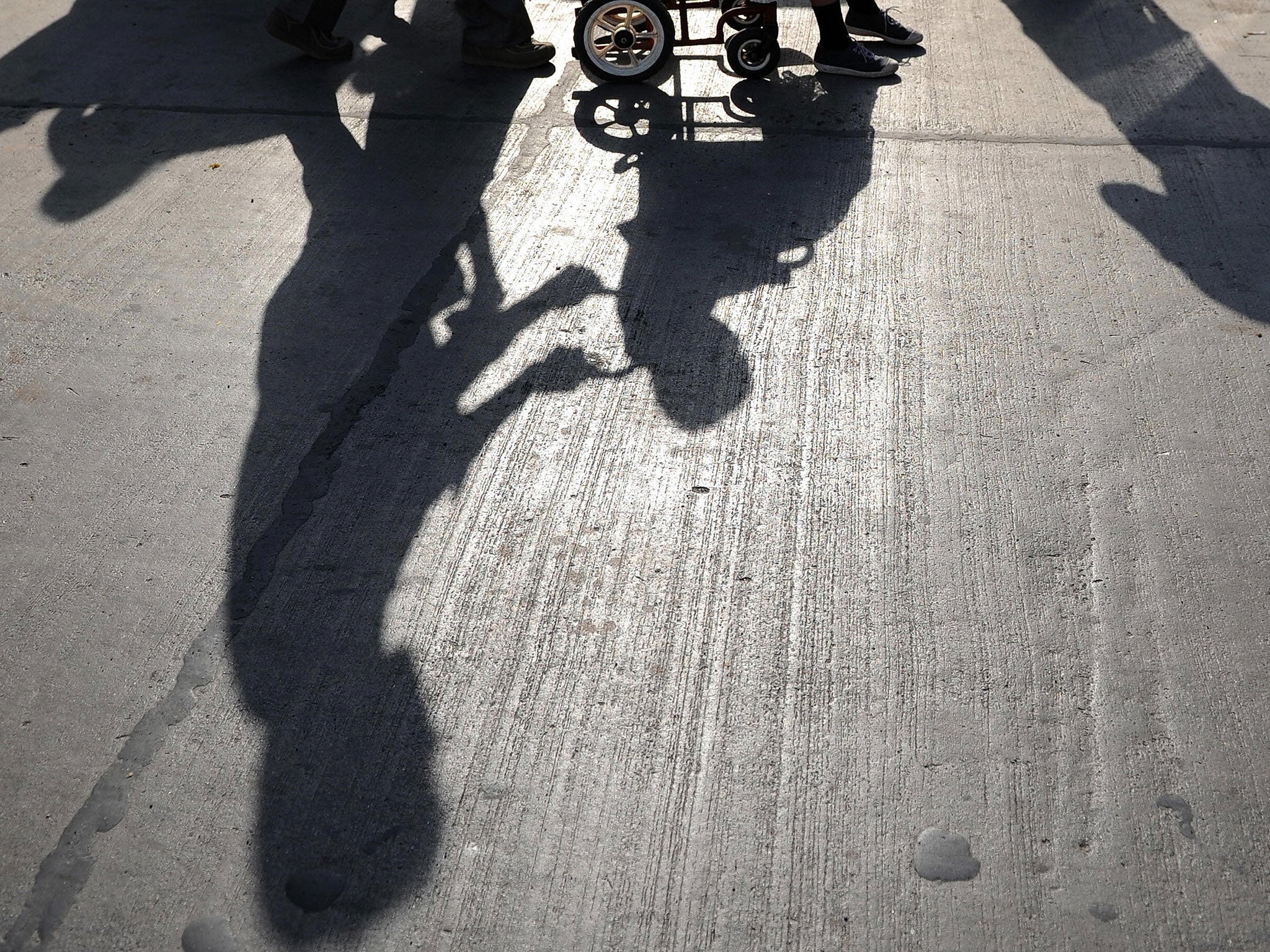This debate is much bigger than just wheelchairs v buggies
Disabled lifts are lifts on the cheap: they send a message that disabled people are different


Your support helps us to tell the story
From reproductive rights to climate change to Big Tech, The Independent is on the ground when the story is developing. Whether it's investigating the financials of Elon Musk's pro-Trump PAC or producing our latest documentary, 'The A Word', which shines a light on the American women fighting for reproductive rights, we know how important it is to parse out the facts from the messaging.
At such a critical moment in US history, we need reporters on the ground. Your donation allows us to keep sending journalists to speak to both sides of the story.
The Independent is trusted by Americans across the entire political spectrum. And unlike many other quality news outlets, we choose not to lock Americans out of our reporting and analysis with paywalls. We believe quality journalism should be available to everyone, paid for by those who can afford it.
Your support makes all the difference.The wheelchair v buggy battle distracts attention from what should be much a much more comprehensive effort on accessibility. The battle returned all too briefly to the headlines earlier this week, when the appeal court ruled that a bus company was within its rights to refuse passage to a wheelchair-user, if someone with a child in a buggy would not vacate the designated space.
Like many people with direct experience of disability, I imagine – including The Independent’s leader writer, in splendid voice the following day – I was incandescent.
My husband, who has Parkinson’s, uses a lightweight walker rather than a wheelchair and has no claim to the wheelchair space on public transport. But I notice time and again on his behalf that those (men and women alike) who steer buggies are among the absolute worst at ceding space even on pavements. And the bigger and more complicated the buggy, the greater – or so it seems to me – their sense of entitlement.
So I hope either that this equal buggy rights judgment is overturned by the Supreme Court or that Parliament legislates to clarify that wheelchairs always have priority. Over recent months, I have heard several radio phone-ins on the subject, and the majority has always favoured wheelchairs by a huge margin. I’m sorry if your buggy is hard to fold (maybe you should have considered that before you took it on a bus) or if your baby woke up when you had to transfer it to your lap, but for wheelchair users there are no other options.
All that said, however, it was a pity that the latest round of this highly charged debate came when it did, because it knocked off the headlines a separate discussion about accessibility that arguably – and potentially – affects even more people.
This was a report, for the Department of Work and Pensions by DisabilityGo, which found that one in five high street shops and restaurants (out of 30,000 inspected) is inaccessible to those in wheelchairs, and two in five have no accessible loos or changing rooms. The findings were described as “shocking”. Frankly, though, I was astonished that so many were accessible. My experience of negotiating high streets with my husband would have suggested the ratio was considerably worse.
Our local library, for instance, was placed by the planners in their wisdom on the lower ground floor of a brand-new building, with only spiral stairs and a disabled lift to reach it – a disabled lift moreover which requires quite some hand strength to operate and is out of order more often than it works.
The disabled lift is an example, I fear, of the perverse effect that accessibility regulation can have. Once this cut-price contraption has been installed for the benefit of wheelchair-users – and perhaps a ramp or two if absolutely necessary – businesses sit back, satisfied that the job has been done. And it sort of has: they have complied with the law. But providing wheelchair access is all too often treated as the most that can be done, rather than the least that the law requires. For while ramps and disabled lifts help many people who are less mobile – and not just those in wheelchairs – there is far, far more that would make life more civilised for many more people.
Disabled lifts are lifts on the cheap; they send the message that disabled people are different, while allowing businesses to disregard the needs of others who find stairs difficult: those parents with babies in buggies, for instance, or an elderly person with a stick, or those encumbered by shopping or luggage. Once the clunky disabled lift has been put in, though, you can generally rule out other kinds of help.
I recently went round our new cinema with Phil, who helps manage the place, to show him what was right and what – in my view – was wrong with its accessibility. First, obviously, the clunky lift just for the disabled. Second, the heavy front doors with no sensor or button to facilitate entry (“security”, he said). Third, there are only stairs to the trendy cocktail bar – what does that say about who they want in there? As for enjoying a drink (as is offered) in the downstairs space by the cinemas, the low chairs and high bar stools make getting seated a challenge, while the tiny and still-lower tables demand improbable feats of balancing, even if all your limbs work perfectly.
The fashion for “boutique” cinemas also has drawbacks. Yes, there are wheelchair spaces at the front (where you have to crane your neck to see the screen too close up). But someone who walks, though with difficulty, will find it hard to reach any other seats. The steps are shallow enough, but there are no rails, and the seat backs on either side are too low to use for support.
Enough of the cinema. We were delighted when a chain sushi restaurant set up close by, but it has only high tables and bar stools. It might as well say: no wheelchairs. Then take public buildings. When I was on crutches for a few weeks, there were buildings I could not even hope to negotiate because of the steps at the front door. Once I was inside, the disabled lift was invariably locked, with a whole hassle to find the key.
This is not to say that the statutory emphasis on wheelchair access is wrong. Much of what is essential for wheelchair-users helps others, too. But far more accessibility and convenience can be designed into facilities in ways that can benefit everyone. If you have the right sort of loos, handles, bannisters, chairs, ramps, lifts and the rest, there need be far less segregation for disability. In Stockholm recently, I found fabulous lifts almost everywhere: smaller and lighter than most of ours, with doors that open on approach. As people live longer, more and more of us will need, and welcome, that sort of help.
Perhaps Ukraine should focus on aid rather than trade
I spent some time this week at the grandly named Ukrainian Investment Summit in London. It is an annual event designed to showcase the opportunities for international, including British, business in Ukraine, while trying to communicate, more or less tactfully, to the Ukrainian side what it is doing right – and wrong.
There are surely prospects there, especially in the poorly developed agricultural sector. But I couldn’t help wonder also about the timing of this gathering; with the ceasefire in the east of the country barely holding, the economy in meltdown, and massive aid – rather than trade – the more immediate, and realistic, priority.
Most of all, though, I wondered about Ukraine’s central PR pitch, which seemed to be: believe us, we have changed – against a backdrop of videos replaying scenes of mayhem in central Kiev last February. Reliving the “revolution of dignity”, as it is now described, may galvanise unity and ambition at home (if you exclude the east). But I rather suspect that stable government and a demonstrative drive against corruption might impress foreign business more.
The mayor of Kiev, boxer-turned-politician Vitali Klitschko, had a better idea when he said he was putting his reputation – “all I have” – on the line and would personally take up the cause of foreign investors who found themselves ensnared in red tape and illicit demands for money. That’s more like it. But the question remains: can even this heavyweight deliver?
Join our commenting forum
Join thought-provoking conversations, follow other Independent readers and see their replies
Comments